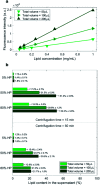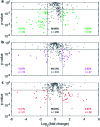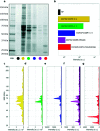Optimal centrifugal isolating of liposome-protein complexes from human plasma
- PMID: 36133013
- PMCID: PMC9418580
- DOI: 10.1039/d1na00211b
Optimal centrifugal isolating of liposome-protein complexes from human plasma
Abstract
In the past few years, characterization of the protein corona (PC) that forms around liposomal systems has gained increasing interest for the development of novel therapeutic and diagnostic technologies. At the crossroads of fast-moving research fields, the interdisciplinarity of protein corona investigations poses challenges for experimental design and reporting. Isolation of liposome-protein complexes from biological fluids has been identified as a fundamental step of the entire workflow of PC characterization but exact specifications for conditions to optimize pelleting remain elusive. In the present work, key factors affecting precipitation of liposome-protein complexes by centrifugation, including time of centrifugation, total sample volume, lipid : protein ratio and contamination from biological NPs were comprehensively evaluated. Here we show that the total amount of isolated liposome-protein complexes and the extent of contamination from biological NPs may vary with influence factors. Our results provide protein corona researchers with precise indications to separate liposome-protein complexes from protein-rich fluids and include proper controls, thus they are anticipated to catalyze improved consistency of data mining and computational modelling of protein corona composition.
This journal is © The Royal Society of Chemistry.
Conflict of interest statement
There are no conflicts to declare.
Figures






Comment in
-
Comment on "Optimal centrifugal isolating of liposome-protein complexes from human plasma" by L. Digiacomo, F. Giulimondi, A. L. Capriotti, S. Piovesana, C. M. Montone, R. Z. Chiozzi, A. Laganá, M. Mahmoudi, D. Pozzi and G. Caracciolo, Nanoscale Adv., 2021, 3, 3824.Nanoscale Adv. 2022 Nov 30;5(1):290-299. doi: 10.1039/d2na00343k. eCollection 2022 Dec 20. Nanoscale Adv. 2022. PMID: 36605796 Free PMC article.
Similar articles
-
Best practice in reporting corona studies: Minimum information about Nanomaterial Biocorona Experiments (MINBE).Nano Today. 2019 Oct;28:100758. doi: 10.1016/j.nantod.2019.06.004. Epub 2019 Aug 17. Nano Today. 2019. PMID: 32774443 Free PMC article.
-
Technical tip: high-resolution isolation of nanoparticle-protein corona complexes from physiological fluids.Nanoscale. 2015 Jul 28;7(28):11980-90. doi: 10.1039/c5nr02618k. Epub 2015 Jun 25. Nanoscale. 2015. PMID: 26108682
-
Isolation methods commonly used to study the liposomal protein corona suffer from contamination issues.Acta Biomater. 2021 Aug;130:460-472. doi: 10.1016/j.actbio.2021.06.008. Epub 2021 Jun 9. Acta Biomater. 2021. PMID: 34116227
-
Isolation methods for particle protein corona complexes from protein-rich matrices.Nanoscale Adv. 2020 Jan 9;2(2):563-582. doi: 10.1039/c9na00537d. eCollection 2020 Feb 18. Nanoscale Adv. 2020. PMID: 36133244 Free PMC article. Review.
-
Research progress and application opportunities of nanoparticle-protein corona complexes.Biomed Pharmacother. 2021 Jul;139:111541. doi: 10.1016/j.biopha.2021.111541. Epub 2021 Apr 10. Biomed Pharmacother. 2021. PMID: 33848776 Review.
Cited by
-
Nanotechnology Meets Oncology: A Perspective on the Role of the Personalized Nanoparticle-Protein Corona in the Development of Technologies for Pancreatic Cancer Detection.Int J Mol Sci. 2022 Sep 13;23(18):10591. doi: 10.3390/ijms231810591. Int J Mol Sci. 2022. PMID: 36142503 Free PMC article. Review.
-
Impact of Lipid Composition on Vesicle Protein Adsorption: A BSA Case Study.ACS Omega. 2024 Apr 12;9(16):17903-17918. doi: 10.1021/acsomega.3c09131. eCollection 2024 Apr 23. ACS Omega. 2024. PMID: 38680315 Free PMC article.
-
Opsonin-Deficient Nucleoproteic Corona Endows UnPEGylated Liposomes with Stealth Properties In Vivo.ACS Nano. 2022 Feb 22;16(2):2088-2100. doi: 10.1021/acsnano.1c07687. Epub 2022 Jan 18. ACS Nano. 2022. PMID: 35040637 Free PMC article.
-
Magnetic Levitation Patterns of Microfluidic-Generated Nanoparticle-Protein Complexes.Nanomaterials (Basel). 2022 Jul 11;12(14):2376. doi: 10.3390/nano12142376. Nanomaterials (Basel). 2022. PMID: 35889600 Free PMC article.
-
Structuring lipid nanoparticles, DNA, and protein corona into stealth bionanoarchitectures for in vivo gene delivery.Nat Commun. 2024 Oct 23;15(1):9119. doi: 10.1038/s41467-024-53569-8. Nat Commun. 2024. PMID: 39438484 Free PMC article.
References
LinkOut - more resources
Full Text Sources
Miscellaneous

